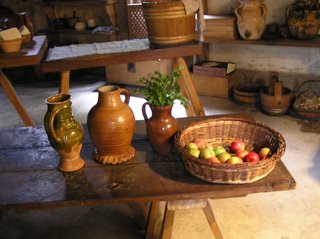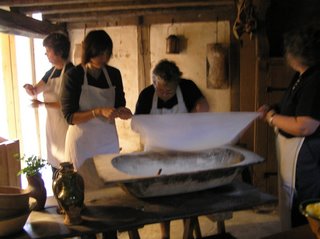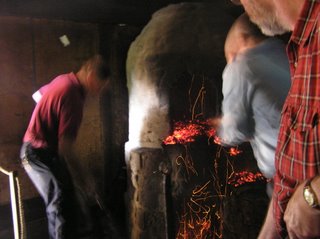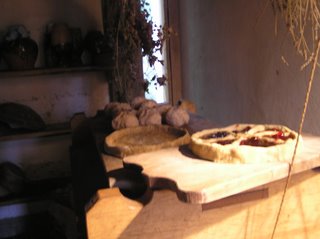
At last I'm getting to the final part of my visit to Sussex and, as I'm fighting off a migraine, this is likely to be fairly short and sweet but I want to get it done before I go again next week for another course, this time on preserving food in Tudor times. Fortunately I kept a journal of sorts otherwise I'd be struggling to remember what happened by now!. The photographs will be mostly of the Weald and Downland Museum as the ones I took inside Winkhurst kitchen of the breadmaking etc turned out very badly, there is no electric light, only the light from the door and tiny windows plus candles and I'm not a good enough photographer yet to make the right adjustments.

There were eight of us doing the Tudor Bakehouse course, four men and four women. It's very unusual to get an even balance like that, usually there are only one or two men at most. The men were very useful as they did all the playing with fire to get the oven heated up and had a thoroughly good time doing it. Did their masculine egos no end of good as we ladies looked on admiringly! In the morning we made just plain household bread using flour as it would have come from the miller ie wholemeal - really wholemeal which makes a very solid and filling loaf. It's possible to make finer flour by sieving which removes a good portion of the bran but still leaves what we would consider a wholemeal flour and then it's possible to boult it which is incredibly hard work.
 The wholemeal flour is rubbed through a muslin cloth using a large wooden ladle and it takes forever to produce quite a small amount of fine white flour. As you can imagine this sort of flour was used only on special occasions and in wealthy households. The photo isn't very clear and was taken on the second day when we were all women, only two of us did both days.
The wholemeal flour is rubbed through a muslin cloth using a large wooden ladle and it takes forever to produce quite a small amount of fine white flour. As you can imagine this sort of flour was used only on special occasions and in wealthy households. The photo isn't very clear and was taken on the second day when we were all women, only two of us did both days.We made bread with two doughs, one left overnight to rise in a cool atmosphere and the other made that morning and using the traditional warm rise.

The overnight rise actually made much nicer bread and I'm going to give that a try in the near future.
 While the dough was rising the oven was fired up, it took 5 large bundles of sticks to heat it to sufficient temperature to bake bread.
While the dough was rising the oven was fired up, it took 5 large bundles of sticks to heat it to sufficient temperature to bake bread. When you judge it is hot enough, the fire embers are raked out and the inside is given a quick once over with a damp bundle of rags on a stick and the loaves are loaded in with a paddle. The wooden oven door, which has been soaking in water is then quickly put in place and sealed with a mixture of flour and water mixed to a sort of sticky pastry consistency - my job for this particular time and as I always make my pastry by hand rather than machine I was able to judge the consistency pretty well.
When you judge it is hot enough, the fire embers are raked out and the inside is given a quick once over with a damp bundle of rags on a stick and the loaves are loaded in with a paddle. The wooden oven door, which has been soaking in water is then quickly put in place and sealed with a mixture of flour and water mixed to a sort of sticky pastry consistency - my job for this particular time and as I always make my pastry by hand rather than machine I was able to judge the consistency pretty well. The term the 'upper crust' comes from this process as, of course, the bottom of the loaves tends to be rather black fom the residue of the ashes, consequently the bread was sliced horizontally and the wealthy family members got the nice clean upper crust and the servants and also rans got the grotty bits off the bottom - so now you know!
The term the 'upper crust' comes from this process as, of course, the bottom of the loaves tends to be rather black fom the residue of the ashes, consequently the bread was sliced horizontally and the wealthy family members got the nice clean upper crust and the servants and also rans got the grotty bits off the bottom - so now you know!
By the time the bread came out of the oven it was time for lunch which we had sitting in the warm sunshine by the lake. Then it was back to the kitchen to prepare dough to make fancy breads, we divided into three groups and one lot made a panettone type dough, another did a herby bread and my group made something similar to Scottish Black Bun - a heavily fruited and spiced dough enclosed in a plain dough case (Black Bun actually has pastry as the outer case). The oven was fired again - more good times for the boys - and the various breads were baked. Of all of them I liked the herb one best, that group had used a lot of fennel among their herbs and as I love the taste of aniseed it really appealed to me. Then came the really hard work as we had to clean all the utensils and scrub the wooden tables using salt as a scourer and a disinfectant.
The next day we made all kinds of pastry and pies. We split into groups again and my partner and I made a bean tart using butter beans as the main ingredient. It neither sounded nor looked particularly appetizing but those who tasted it said it was actually very nice. Other things made were a jam tart, apple dumplings and custard tarts.
 As on the previous day the oven was fired twice, once in the morning and once in the afternoon. In the afternoon we all made hot water crust pastry which is something I like to eat but have never tried to make before. It was surprisingly easy and I shall certainly have a go at the filling I concocted for mine using apples, raisins, brown sugar and cinnamon topped off with walnuts of butter. Others made savoury fillings using fish and herbs or cheese and onions.
As on the previous day the oven was fired twice, once in the morning and once in the afternoon. In the afternoon we all made hot water crust pastry which is something I like to eat but have never tried to make before. It was surprisingly easy and I shall certainly have a go at the filling I concocted for mine using apples, raisins, brown sugar and cinnamon topped off with walnuts of butter. Others made savoury fillings using fish and herbs or cheese and onions. Unfortunately the course finished before these had baked so we never got to try the results of our labours. I just know that apple-y/cinnamon thing of mine was good though. It will all have been eaten the following day by volunteers and visitors to the museum.
Unfortunately the course finished before these had baked so we never got to try the results of our labours. I just know that apple-y/cinnamon thing of mine was good though. It will all have been eaten the following day by volunteers and visitors to the museum.
As I was leaving I took these photographs of Romany caravans and the traditional piebald horses as well as the colourful miniature Romany caravan below , both were part of the preparation for a weekend about Romany people and their way of life. I wish I could have seen that, it must have been fascinating.

OK Bloggger is at it again, it's says it has uploaded photos but they are not appearing. It's been like this since last night so I'm going to publish this now and keep trying to edit the photos in during the day. I'm going to be at home baking and writing letters so I can do it in between things - I hope!
Success! Thanks to those who reminded me about Mozilla Firefox, it's worked the oracle. The photos have all turned out to be of the course after all so I'll put up some of the rest of the Museum tomorrow.








14 comments:
Wow, I wish I could be following in your footsteps! I've always had a strong connection with Tudor times, it shows up in my dreams a lot. I have a rather strong distaste for Henry the 8th but a very strong draw to the food, the clothes, the homes. It was the last flower of the medieval, the beautiful rose. I really look forward to what unravels in your journey about how they preserved their food!
With blogger, I have downloaded the free firefox browser (was told its more compatible with blogger) and so when blogger acts up then I switch over and do it from firefox. Seems to work : )
Rowan,
That course sounds delightful! We baked all our own bread for years when the children were at home. I found the process to be very relaxing, and the varied aromas along the way, from dough to finish were tantalizing. Also I found the kneading to be theraputic. Your course sounds very inviting, but I must say that today I am thankful for electicity, lol ;-)( Oh, but I would attend a course akin to yours given the opportunity).
I still use IE (internet explorer) for browsing the various blogs that I visit, and also to make comment.
For posting I use Mozilla/firefox exclusively. My pics always load. So, I do think there is a feud of sorts going on between Blogger and IE.
Hope your headache dissipates, and you can enjoy the weekend.
rel
P.S. Don't hesitate to tease ;-)
Presevering In Tudor times how intersting! mmm...the apple dumplings and custard tarts yummo! I loved the wooden tables and the wooden bowl with the bread dough!Oh poor you with migraine I know how you feel as I have them too! I could NEVER work on the computer with one!!Nice meeting you..NG :)
Love the smell of homemade bread in the oven. Your post is wonderful....a connection to those that went before and all the work it took them to bring food to the table.
Sounds like fun, but a lot of work! I can just imagine the wonderful aroma of warm bread, and the flavor ...
Jeanne
This sounds like a VERY interesting course! I have always been interested in Elizabethan England..... Thank you for sharing a "below-stairs" glimpse with us!
I discovered by accident that when blogger says it has uploaded pics but I can't see the html for them, if I "paste" into the editing window, they sometimes magically appear. Not always, but sometimes.....
Another thing that has worked is to take the html for displaying another photo, and just change the name of the pic. Blogger seems to keep the same name for pics as I had on my computer (unless I have uploaded multiple copies for one reason or another, and then it adds a .0 .1 .2 etc, before the .jpg.
Note that the blogger code names the pic twice in the little block of text, and you'll need to change it in both places to have your new pic show up.
That doesn't always work, either, but it seems that if I try both of those tricks, usually one of them will work.....
-- Vicki in Michigan
Rowan,
Wow, those pictures finish off your story with just the perfect touch.
Glad you are persistent!
rel
I'm glad you stopped by my blog, and thank you for the compliments!
I think your photos are just fine -- taking pics in dark places, especially when people are moving, is very difficult. Your pics are very good documentation of what happened in your class, and really help us see what you described.
When you describe a "cold rise overnight" -- how cold? Cool room temperature, or? Thanks!
It occurs to me that another thing to try when blogger is misbehaving is to "save as draft" even if it doesn't seem to have the pics. I don't know if the invisible pics would show up when that saved-as-draft post was edited, but the next time I can't make it find my pics, I'm going to try it.....
Oh my!! I can`t imagine having to go through all that years ago while boiling the whites, scrubbing the clothes, salting meat......whew!
But it sure is interesting. I love your pearls and also like Glen Miller Thanks to my Mum.
tea
xo
This was so interesting..I can almost smell the fresh baking as I look at your photos.Most of us would be lost with no electricity, but with all your new found skills I don't think you would even notice.Hard work perhaps, but so satisfying.
That was so interesting, I never realised that the door was sealed in place with a pastry substance. Also I liked the explanation of 'Upper Crust'
That sounds so interesting. I'm sure all that baking was appreciated the next day by the volunteers.
The Romany caravans really struck my fancy. I've always been fascinated with gypsies and such.
Sounds like you had a lovely time. It's just the sort things I'd like to go and do. I bake bread every week but these days I knead it in my kitchen aid as it makes my arms ache to do it by hand. I still bake it the conventional way though - nothing like homemade bread.
This course, and the course in Wales, sound like just the thing I would like to do when my children are a little older. I know we come from different spiritual paths Rowan, but we do have much in commom. Thank you for this wonderful entry!
Post a Comment